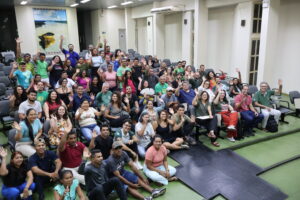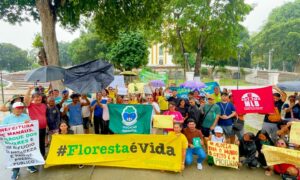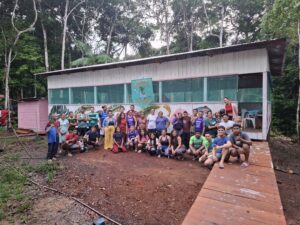By Clara Machado
Whaldener Endo, known to his friends as Óleo, is a biologist, with a PhD in Ecology and Natural Resource Management from the Norwegian University of Life Sciences (NMBU). He is currently an adjunct professor at the Federal University of Roraima. His academic trajectory focuses on Ecology and Conservation of terrestrial vertebrates, including topics such as the sustainability of subsistence hunting, conflicts between humans and animals and the effectiveness of establishing protected areas for the protection of biodiversity. Óleo participated in the initial phases of the Médio Juruá Project (PMJ) and the Programa de Monitoramento da Biodiversidade e do Uso de Recursos Naturais (ProBUC), contributing to fauna monitoring and data collection activities along the Juruá River. We invited Óleo to talk about his experience in the middle Juruá and his academic trajectory that involves such relevant subjects to the conservation of fauna and terrestrial environments.
INSTITUTO JURUÁ. Could you, please, tell us about your academic trajectory and career?
WHALDENER ENDO. My name is Whaldener Endo, and Oléo is a nickname that I carry for many years, it is a kind of abbreviation of my name. I’m from São Paulo, where I graduated in Biology. I first came to the Amazon working with tourism, in the Mamirauá region. I returned to academia with a master ‘s degree at the Instituto Nacional de Pesquisas da Amazônia, and then I had a doctorate in Norway. I am currently a professor at Universidade Federal de Roraima for almost three years. I have always been very interested in contact with nature, I have always loved animals and this has always motivated me to pursue my career. My origin is from a reality far from the natural environment, I usually joke that I played marbles on the carpet. But it motivated me to look for opportunities to learn about nature-related issues. Academically speaking, I have always been interested in Conservation Biology and Ecology, linked mainly to groups of animals, such as mammals and birds.
INSTITUTO JURUÁ. You have participated in the creation and initial phases of the Médio Juruá Project (PMJ). How was this experience, especially with regard to the terrestrial environment, that were the priority activities at the time?
WHALDENER ENDO. The opportunity to work in the Juruá region came through Dr. Carlos Peres. I had already worked in Peru, in Manú National Park with him, and after this project I worked at the Amazonas State Environment Secretariat, in 2007 with Virgílio Viana, when they were establishing several conservation units, among them the Uacari Sustainable Development Reserve, and this was my first contact with the region. On the first trip I made to Juruá, I set up a tent on a beach to spend the night and later I realised that it was a protected turtle nesting beach! This was my first contact, participating in ProBUC (Program for Monitoring Biodiversity and the Use of Natural Resources), through the Amazonas State Environment Secretariat. Then, Dr. Carlos Peres obtained financing from the Darwin Initiative and I was invited to start the Projeto Médio Juruá, as a field manager, helping with issues related to the initial activities of the project.
INSTITUTO JURUÁ. How was the experience of ProBUC (Program for Monitoring Biodiversity and Use of Natural Resources) in the mid-Juruá region?
WHALDENER ENDO. When I worked at the Amazonas Environment Secretariat, the ProBUC pilot program was being established, with the intention of later replication in other units. This was in 2007 and PMJ started activities at the end of the same year, so they were almost synchronized. The big difference is that PMJ expanded outside the conservation units while ProBUC was more focused on protected areas, and that PMJ focused on gathering and analyzing data, with more specific academic activities such as master’s and doctoral projects. ProBUC had different action fronts, such as monitoring fauna and river beaches, other extractive activities, as well as monitoring vessel activities. PMJ and ProBUC were community-based projects, so both had massive involvement of several people from different communities, and the idea was to provide more autonomy so that community members could run these monitoring projects by themselves.
INSTITUTO JURUÁ. How long have you been working in the mid-Juruá region?
WHALDENER ENDO. I started working at mid-Juruá in 2007, and lived in the region from the end of this year until 2009. The following year I started my doctorate in Norway, and then I visited Juruá frequently for field activities. Most of the time I lived there was on board the boat Hiléia, along with Almir and other people. There are many different realities in the region, along the river, in Carauari, in each conservation unit and Indigenous Lands. I had the opportunity to work on the Xeruã River, in the Indigenous Lands of the Deni and Kanamari Peoples and it is quite different there, and even unknown by the residents of the other areas. So, there are different points of view. I learned a lot by working in this natural reality and in the interactions with the communities. Each community has its own profile and its own teachings.
INSTITUTO JURUÁ. With your experience in mid-Juruá, how do you evaluate the hunting relationships and the interaction between animals and people in the region, which is a common topic in your studies?
WHALDENER ENDO. Among the intra-regional differences, the most drastic is the dependence on hunting. For example, within the Indigenous Lands, the dependence on hunting is much greater than in the communities along the Juruá. There are also some patterns, for example, the more distant from the Juruá border, the greater the dependence on hunting. In addition to this association with the main river, there is a relation with the economic activities that the communities carry out, for example, the communities that live more from fishing are associated with this type of environment, while those that live on rubber, murumuru, and other resources end up having greater permanence of the forest, mainly influencing opportunistic hunting activities. In general, hunting reliance in communities along the Juruá River is low compared to other regions in the Amazon. The proportion of food from fishing is much higher than consumption from hunting. In the Juruá, hunting has this opportunistic characteristic, and this is directly related to the economic activity that the community performs.
INSTITUTO JURUÁ. Have you tried any food with a traditional preparation that caught your attention in Juruá? And what is the favorite and most hunted animal in the region?
WHALDENER ENDO. By living with local communities, we end up trying some game meat and, really, there are some species that after we have tasted it, we understand the reason for it to suffer great hunting pressure. The queixada (white-lipped peccary) is a much appreciated meat, while the turtles, such as tracajá, are animals with great potential for sustainable management for commercial purposes. And there are the different techniques that people use, for example, the mixira, which is made with queixada and but also often from manatees too. In mixira, the meat is preserved inside the animal’s own lard, and this makes the meat last much longer. The preferred game in the region and in the Amazon in general are peccaries, mainly the queixada. It is a very vulnerable species, so it runs the risk of becoming much less abundant and suffering local extinctions, disappearing in some areas. The most hunted species are peccaries, tapirs, and large birds, such as curassows. Primates are seldom hunted because eating them is an uncommon habit in the region.
INSTITUTO JURUÁ. How could community-based management of fauna contribute to biodiversity conservation? What are the challenges that these activities face today in Brazil and the prospects for the future?
WHALDENER ENDO. Several studies show that the greater the involvement of local communities in the various stages of the development of a management plan, the greater the probability of success of the proposal. This involvement was traditionally more related to field assistance for data collection, but today it is already known that it cannot be restricted to this. It is a key issue to involve local populations right from the identification of which metrics to be used, and the resources to be managed, up to the later stages, such as evaluation, so that the plan is viable. Another important issue is that proposals for the management of natural resources need to face many factors that go against what we want to achieve, so it is important to have strong components that reinforce the proposal. The greater the community engagement, the greater the probability of success; a portion of the community that does not adhere can cause such a negative impact that it makes the whole proposal unfeasible. Another challenge is that having reliable information takes a lot of effort. It takes a high investment of time and resources to have good estimates, even though new technologies and analyzes are helping to overcome this bottleneck. For example, population density estimates require an effort of several days in the field, with many kilometers of census, which was precisely the work of ProBUC and PMJ. Medium and large-bodied animals are important indicators of environmental health in natural areas, as they are the first members of biodiversity to leave, so it is necessary to include these groups, not least because besides their ecological importance, they are also the basis of subsistence for many families.
INSTITUTO JURUÁ. Could you, please, explain the relationship between subsistence and commercial hunting in Brazilian legal terms? And, besides management, are there other alternatives to reduce the hunting pressure that these animals suffer?
WHALDENER ENDO. Subsistence hunting is protected by law in Brazil; hunting to kill hunger is not a crime, but commercial hunting of wild animals is not allowed. What often happens is the arbitrary judgment of the inspectors when they are faced with the situation of people carrying game meat. In addition to fauna management, one of the proposals mentioned is the generation of alternative sources of income, so if financial alternatives are provided to support families that live from hunting, the hunter often changes activities. The commercialization of game is not really profitable, so with an alternative income there is the possibility that hunters will change their activity. There are cultural issues involved as well, in which case the work is bigger and requires the power of the law through inspection activities to minimize these problems. The future could be very promising in terms of technological advances. For example, there are initiatives to monitor elephant populations through transmitters, linking this to benefit programs, so that the local populations that help to maintain these elephants benefit from an income source as long as the elephant population remains protected.
INSTITUTO JURUÁ. Could these alternative sources of income, besides reducing the commercialization of game, generate changes in culturally established eating habits, such as the greater purchase of industrialized meats? How do you perceive this process of food transition?
WHALDENER ENDO. One perception I have is that there is a relationship between government benefits, such as Bolsa Família and Bolsa Floresta, and the link with urban centers, because it is necessary to go frequently to the city to withdraw the benefit, and increasing these trips, the consumption of food that comes from the city also increases. In relation to distance, for example on the Xeruã river, communities that are more distant have a considerably lower frequency of contact with the city while the dependence on local resources increases and products from the city are consumed less. The younger generations may lose a little of that contact with nature, this can be negative in some aspects and positive in others. For example manatee fishing, which is practically an art, the art of manatee fishing. As manatee is an extremely discreet animal, the fisherman needs to know how to read the clues of nature, how the grass is chewed, to predict where the manatee will surface, and this is a knowledge that is lost, but which ultimately helps reduce hunting pressure on manatee populations. So, these cultural changes can influence negatively, but often also positively.
INSTITUTO JURUÁ. Regarding the relationship between people and animals and their inherent conflicts, from a broader point of view, what can science and decision-makers learn from indigenous, riverside and other traditional populations in Brazil?
WHALDENER ENDO. When you have the opportunity to live with a traditional population, you realize that there are habits that are conscious or even unconscious that favor the sustainability of extractive activities. In most traditional communities, you leave the house and in a hundred meters you are already in a secondary or primary forest, and this is not usual in communities that live in the Amazon but that bring habits from outside, such as the culture of monoculture. So, these habits are in the daily lives of residents and facilitate sustainability in the use of resources, some of which have already been lost in some populations, such as the habit of moving from one area to another, which was common in indigenous peoples. Movements to another area happened according to the scarcity of some resource, allowing the recovery of the previous inhabited area. These habits are no longer seen as often in the Amazon, but other traditional habits remain and they are the ones that favor the sustainability of agroextractivism.






